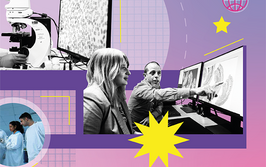
The Race Against Resistance
Rapid testing could be the tool we need to successfully address antibiotic resistance
At a Glance
- Molecular testing provides rapid turnaround times and accurate results
- For bacterial infections, this can mean the difference between appropriate treatment and the risk of poor outcomes and increasing antimicrobial resistance
- To defeat resistance, labs must not only identify the causative pathogen, but also determine its most likely antibiotic susceptibilities
- Even in their early stages, rapid molecular diagnostics have yielded significant improvements in outcomes for patients with infectious diseases
For many medical situations, molecular testing has enabled previously unimaginable turnaround times to results, making it possible to get patients on the right treatment – or off the wrong one – very quickly. Nowhere is this more important than in the fight against antibiotic resistance. In patients with bacterial infections, rapid diagnostic results allow medical teams to select the targeted treatments most likely to be effective, avoiding prolonged use of the broad-spectrum antibiotics most likely to spur resistance.
Many hospitals have launched antimicrobial stewardship programs for the express purpose of reining in the spread of antibiotic resistance. These programs use every tool in the infection control toolbox – from basic education about handwashing to strict isolation protocols – to prevent both the transmission of resistant strains and the acquisition of new resistance mechanisms. Rapid molecular tests are a key element of these programs. Why? Because they help identify infected patients, detect antibiotic resistance profiles, and guide treatment selection. Some programs even go beyond the standard clinical guidelines, using diagnostic tools to screen all hospital admissions so that asymptomatic, colonized patients can be isolated to reduce the risk of resistant strain transmission.
The rapid spread of resistance
It would be difficult to overstate the severity of the ongoing public health threat caused by antibiotic resistance. Infectious diseases long thought to be conquered have arisen again – and, in some cases, they are impossible to treat with current medications. Experts estimate the global death toll at 700,000 per year, and that number is expected to rise to 10 million by the year 2050 (1).
When the World Health Organization (WHO) released its first report on antimicrobial resistance in 2014, then-Assistant Director-General for Health Security Keiji Fukuda said in a statement, “Without urgent, coordinated action by many stakeholders, the world is headed for a post-antibiotic era. […] The implications will be devastating (2).” In the report, scientific experts detail findings such as the presence of carbapenem-resistant Klebsiella pneumoniae throughout the world (3). This bacterial strain, in some geographic regions, now makes up the majority of K. pneumoniae cases diagnosed – and it is resistant to even the last-resort treatment available.
Yet, believe it or not, this “unbeatable” bug is not even among the most urgent threats from drug-resistant bacteria. Globally, those threats include carbapenem-resistant Enterobacteriaceae, Clostridium difficile, Neisseria gonorrhoeae, methicillin-resistant Staphylococcus aureus, and tuberculosis (4)(5)(6).
More and more, resistance is not limited to a single class of antibiotics. Pathogens are increasingly found to carry resistance markers for multiple treatments, making it difficult for treating physicians to get the upper hand. In a survey of infectious disease practitioners, the majority of respondents reported seeing at least one case in the prior year where the infection-causing bacterial strain was resistant to all available antibiotics (7).
Stewards of health
With the growing prevalence of antibiotic resistance, it is no longer sufficient for clinical laboratories to simply identify the pathogen responsible for a patient’s infection; they must now also detect markers of antibiotic resistance to help physicians select the treatment most likely to be effective. Ideally, that treatment will be a targeted drug (to help prevent further acquisition of antibiotic resistance).
Rapid molecular diagnostics have revolutionized the way clinical labs meet these demands – and the speed with which they do it. Culture-based testing typically requires at least a day to identify the infectious organism, followed by two days or longer to reveal antibiotic resistance profiles. Molecular testing, on the other hand, can deliver strain identification results in a couple of hours and report resistance markers in less than a day. Getting results faster not only improves patient outcomes, but also helps check the spread of antibiotic resistance.
Rapid diagnostics are also a powerful tool for antimicrobial stewardship programs, which typically aim to reduce the unnecessary use of antibiotics. Identifying bacterial strains early – or ruling out a bacterial source of infection altogether – makes it possible to get patients off the broad-spectrum antibiotics commonly used before diagnostic results are available.
In a recent presentation to the South Central Association for Clinical Microbiology, Ronald Reitenour, Area Coordinator for Microbiology, HAZMAT, and Disaster Preparedness at Riverview Health in Indiana, reported that, by adopting rapid microbial testing for its antimicrobial stewardship program, his hospital had reduced the average length of patient stays, improved outcomes, and lowered costs (8). Similar results have been seen at other institutions. In Florida, a study of more than 400 patients in several community hospitals found that the switch from traditional blood cultures to molecular testing decreased the average time to get patients on appropriate antibiotics by 30 percent – a time savings of 18 hours (9). The same study also showed that the molecular approach contributed to lower readmission rates. Finally, a third study showed that the move to molecular testing enabled doctors in the Orlando Health network to stop unnecessary antibiotic use 27 hours sooner than with traditional testing methods (10).
In some cases, medical teams have determined that it makes sense to expand the use of rapid molecular diagnostics to screen all patients admitted to hospitals, rather than just those with obvious infections. For example, many people are known to be colonized with C. difficile, even though they may be asymptomatic. Research has demonstrated that isolating these patients can reduce the rate of hospital-associated C. difficile infections – often a challenge in patients already suffering from other illnesses or injuries, and particularly so when the disease does not respond to antibiotic treatment. A study at an acute care facility in Canada found that, after the implementation of screening protocols for all patients, the incidence of C. difficile infections dropped substantially; in fact, the approach was estimated to have prevented 62 percent of expected infections and saved as much as CA$627,000 (11). In Denmark, a study in two university hospitals found that patients exposed to asymptomatic carriers of C. difficile were more likely to develop infections – 4.6 percent of those patients suffered C. difficile infections, compared to only 2.6 percent of patients who were not exposed to asymptomatic carriers (12).
Looking ahead
The epidemic of antibiotic resistance demands new solutions and creative approaches from all stakeholders, including clinical lab and hospital teams, diagnostic developers, and pharmaceutical and biotechnology companies. Rapid molecular diagnostics represent a relatively new weapon in the stewardship arsenal, helping to avoid two of the biggest contributors to the acquisition of drug resistance: unnecessary antibiotic use and prolonged exposure to broad-spectrum antibiotics. Increased adoption of these tests should significantly boost the effectiveness of antimicrobial stewardship programs and other infectious disease control measures, leading to a stronger defense against infection and better health for patients.
Sherry Dunbar serves as Senior Director of Global Scientific Affairs for Luminex, Austin, USA.
- The Economist, “The grim prospect” (2016). Available at: econ.st/2xBSVys.
- Accessed May 11, 2018.
- World Health Organization, “WHO’s first global report on antibiotic resistance reveals serious, worldwide threat to public health” (2014). Available at: bit.ly/1mY1jNf. Accessed May 11, 2018.
- World Health Organization, “Antimicrobial resistance: global report on surveillance” (2014). Available at: bit.ly/2rGPwJZ.
- Accessed May 11, 2018.
- Centers for Disease Control and Prevention, “Biggest threats” (2018). Available at:
- bit.ly/29286mX. Accessed May 11, 2018.
- CL Ventola, “The antibiotic resistance crisis: part 1: causes and threats”, P T, 40, 277–283 (2015). PMID: 25859123.
- World Health Organization, “Antimicrobial resistance” (2018). Available at:
- bit.ly/2IaAq6i. Accessed May 11, 2018.
- AL Hersh et al., “Unmet medical need in infectious diseases”, Clin Infect Dis, 54, 1677–1678 (2012). PMID: 22474176.
- RE Reitenour, “Adaptive molecular solutions: the right fit for your laboratory”. Presented at the spring meeting of the South Central Association for Clinical Microbiology; March 23, 2017; Indianapolis, USA.
- C Fronczek et al., “Impact of the Verigene rapid diagnostic blood test as an antibiotic stewardship tool amongst hospitalized patients in a community healthcare system”. Poster presented at IDWeek 2016; October 28, 2016; New Orleans, USA. Poster #1001.
- J Fox et al., “Effect of implementing the Verigene Gram-positive blood culture nucleic acid test (BC-GP) on stewardship outcomes and cost in blood stream infections (BSI)”. Poster presented at IDWeek 2016; October 29, 2016; New Orleans, USA. Poster #1877.
- Y Longtin et al., “Effect of detecting and isolating Clostridium difficile carriers at hospital admission on the incidence of C. difficile infections: a quasi-experimental controlled study”, JAMA Intern Med, 176, 796–804 (2016). PMID: 27111806.
- T Blixt et al., “Asymptomatic carriers contribute to nosocomial Clostridium difficile infection: a cohort study of 4508 patients”, Gastroenterology, 152, 1031–1041 (2017). PMID: 28063955.
Sherry Dunbar serves as Senior Director of Global Scientific Affairs for Luminex, Austin, USA.




















